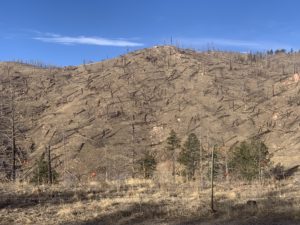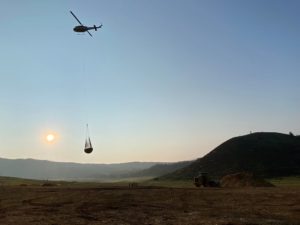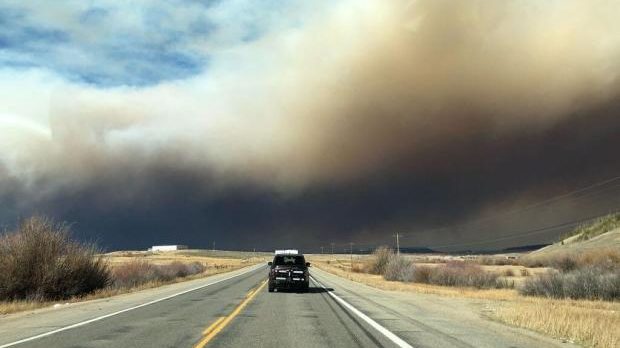During the late summer and early autumn of 2020 Northern Colorado experienced the two largest wildfires in our state’s history. With more than 400,00 acres scorched, encompassing more than 625 square miles, the devastation was nearly unfathomable. Swift and coordinated recovery efforts across the burned landscapes began before the final flames were even extinguished. The watershed restoration work has been a race against the clock as the deadly debris flow in the Poudre Canyon’s Black Hollow community proved in July of 2021. Yet the recovery efforts that have occured in the wake of the Cameron Peak and East Troublesome fires have been as historic as the fires themselves.
A Monumental Effort

Since day one, a diverse yet united alliance of both private and public stakeholders have stepped up to provide funding, labor and expertise in both of the impacted watersheds. The list of organizations and agencies involved is substantial and the number of different projects impressive.
The City of Greeley has partnered with the Cities of Fort Collins and Loveland as well as the East Larimer County, Weld County and Fort Collins/Loveland Water Districts to oversee the aerial mulching of more than 5,000 acres in the Cache la Poudre River basin and 800 acres in the Big Thompson River basin. Mulching is just one part of the puzzle with additional recovery work needed across thousands high priority acres across our two watersheds. Local water suppliers have collaborated on the installation of hundreds of erosion control structures on hillslopes in key locations around vulnerable reservoirs. In addition to post wildfire debris removal, hillslope stabilization, erosion control and more, repairs from the fire suppression efforts themselves have been necessary. This included volunteers and crews from other agencies repairing hundreds of miles of hand and dozer lines and the removal of thousands of feet of hose, pumps, fuel cans and more.
The incredible work by our local watershed coalitions, conservations corps, and restoration volunteers should not go unrecognized either. They have coordinated efforts to plant 600+ trees, install erosion control barriers, fell trees, and build check jams to reduce erosion in critical sub-watersheds of the Poudre River.
In the East Troublesome burn area the front was equally unified with more than 40 partner agencies on both sides of the continental divide engaged with one another from very early on. Grand County, Northern Water and numerous other partners worked with 180 landowners to complete aerial seeding/mulching on more than 2,200 acres of private property this past summer. This fall, 2,200 more acres of aerial mulching on USFS land was planned in an effort to reestablish vegetation and reduce erosion in the most heavily burned areas. Additional erosion control efforts included the installation of three massive debris booms by Northern Water in at risk reservoirs on the west side of the divide to protect vital water supplies upon which the Front Range depends. Roads, bridges and culverts have needed repairs and countless burned trees have been removed.
The recovery and repair “to do” list for every agency and organization involved has been monumental but thanks to hard work, dedication and a whole lot of funding the work is getting done to restore and rebuild.
A Staggering Cost

While the fire recovery work is still in the early stages, the costs already incurred are staggering. According to Greeley water and sewer director Sean Chambers, their city has spent more than $40 million in 2021 recovering from the Cameron Peak Fire. Larimer County’s Office of Emergency Management reported their expenditures on the fire will be almost $25 million. Even after federal and state reimbursements the county expects to spend over $17 million out of pocket. And more funding is needed.
Watershed protection needs in the Cameron Peak burn area exceed $45 million and yet Adam Jokerst, Deputy Director of Water Resources for the City of Greeley said only half of these funds have been secured. He explained that aerial mulching in the Poudre is done for now due to “lack of funds”. This comes as no surprise when you discover keeping helicopters in the air dropping mulch costs $87/minute, but it is still the best option especially on remote mountain terrain .
For the East Troublesome fire the recovery needs and the costs associated with them are even bigger. It is estimated that another $51 million is needed above and beyond the $35 million already secured. According to Esther Vincent, Environmental Services Division Director for Northern Water, most of these allocated funds were focused on private lands in strategic downstream locations however this only encompassed 10% of the burn area. Funding for 2022, once secured, will need to be directed at the other 90% on USFS land.

A Collaborative Force
More than 800,000 people in Northern Colorado depend on our forested watersheds to provide us with the lifeblood of our communities, water. These watersheds occur on publicly protected land like Rocky Mountain National Park, but additional lands within the watersheds are owned by other public agencies like the U.S. Forest Service or private landowners. These different ownerships translate into different land management strategies that have the potential to be far more impactful when we work together and coordinate efforts. The wildfires of 2020 taught us many lessons but possibly none more important than the value of collaboration.
In speaking about the recovery efforts Northern Water’s Esther Vincent reflected, “In this process we found at the center, unlikely and previously unforeseen partnerships and newly formed collaborations that have only strengthened in this last year and will likely shape the water community for many years to come. We wouldn’t have been successful in securing funding if we hadn’t been able to work so closely with each other and speak with a unified voice. We’ve done that collectively on both sides of the divide.”
An Ongoing Need
This sentiment rings true for the work that needs to be done to restore the health of the forests that remain as well. Forests throughout the Front Range are at extreme risk for wildfire due to decades of fire suppression, rising temperatures and droughts exacerbated by climate change. Proactively treating fire risk is more cost-effective than fighting wildfires once they break out or treating water supplies with excess sediment from wildfires. If we nurture and grow these “unforeseen partnerships and newly formed collaborations” we can avoid wildfires of this magnitude and protect the forested watersheds upon which we all depend.
